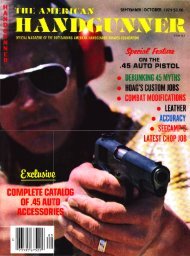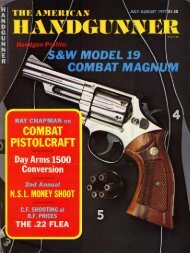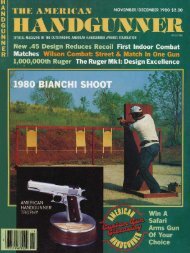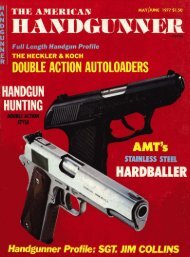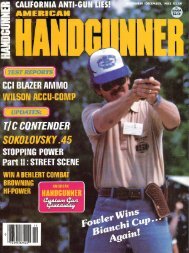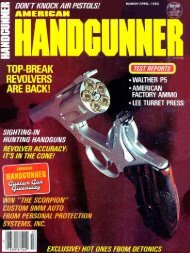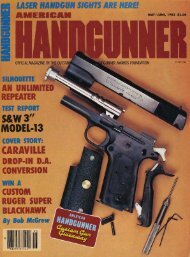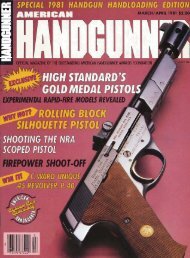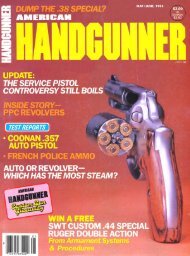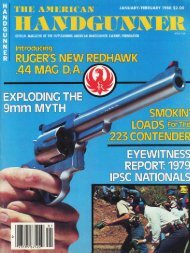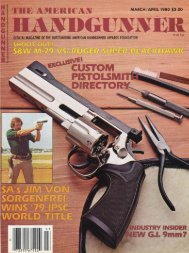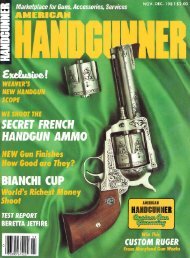July/August 1978 - American Handgunner
July/August 1978 - American Handgunner
July/August 1978 - American Handgunner
You also want an ePaper? Increase the reach of your titles
YUMPU automatically turns print PDFs into web optimized ePapers that Google loves.
PA DISSENTING VIEW ON MAGAZINE SAFETIESolice departments that issue theSmith & Wesson model 39 or 599 mm semiautomatic often cite the magazinedisconnector safety as one reasonfor their choice of pistol. Gun expertsinvariably denounce this feature as compromisingone of the theoretically greatadvantages of the police auto over therevolver: if there is a round in the chamber,and you're jumped while changingclips in the heat of a gunfight, you've gota shot ready to fire.It is safe to say that virtually every gunwriter would be in agreement on the tacticalundesirability of magazine disconnectorsafeties. (To new readers, thefunction of such a device is to make itimpossible for the auto pistol to fire, evenif there is a live round in the chamber,once the magazine has been removed.The concept came about decades ago,when the gunmakers realized that a lot ofaccidental shootings with automaticsoccurred with novices who thought thegun was safe once they removed themagazine.)Indeed, for years I felt thatway. WhenI explained to police students or brotherofficers why I carried a Colt .45 auto onthe job, the ability to fire the chamberedround while reloading was a point I alwaysbrought up. In fact, I wrote in onearticle on the Smith 9 mm that the officercarrying one should remove the disconnectorand have it fashioned into a tieclip, so it would at least perform somekind of a useful function.There are many apparently solid argumentsagainst - the magazine - disconnectorsfound in guns like the Smith 9's orthe Browning Hi-Power auto. If you loseyour clip, and only have loose rounds tofeed it one at a time, you won't be able tocontinue firing. And of course, you loseBy MASSAD F. AYOOBthe ability to shoot if youget pounced onduring the reloading process. There isanother very real danger with this type ofsafety; some police departments thathave ado~ted the Smith auto teach theirmen to remove the magazine and check itin at the booking desk, keeping the nowdeactivatedgun in the holster, whereaswith a sixgun, they'd simply check thewhole weapon before they went down intothe jail area.This latter practice is extremely shortsightedand dangerous for severalreasons. First, few or none of these departmentsmake the officer check hisspare clips too, and checking two or threemagazines is more tedious than handingthe clerk a single firearm. Second, theyassume that none of the officers haveread the gun magazines, and removed themagazine disconnector safety from thepistol.Let's assume that such an officerchecks his magazine at the desk, and escortsthe prisoner into the cell area withhis model 39 or 59 still in the holster.There is a scuffle. As armed brother officersrush toward the noise, the prisoneremerges, holding the downed officer'sauto pistol. The cops have seen themagazine being checked in at the bookingdesk and assume that the gun can't befired. Instead of taking cover from thegun pointed at them, they go for their ownhandguns, or approach confidently totake the supposedly useless gun from thesuspect, barehanded.BANG: Or maybe, BANG BANGBANG.The suspect may have reloaded with amagazine torn from the officer's belt, orperhaps there will be only one BANG, thesingle round in the chamber that wasturned loose because the officer carryingthat particular gun had modified it theway we gun writers had told him. One"bang" is one too many.As to the other advantages of autos thatdon't have magazine safeties, I can onlysay that I have yet to find a case on recordwhere being able to fire the single roundin the chamber while he was reloadingwould have saved a policeman's life. Oh,the auto pistol buffs cite the four CaliforniaHighway Patrolmen gunned down enmasse in 1970 while trying to reload theirrevolvers from drop pouches. That argumentdoesn't translate, though; thesemen had emptied their guns without hittinganything and it is safe to assume thathad they been carrying automatics, theywould have emptied those too, and notsaved the round in the chamber.As far as feeding cartridges one at atime, any police officer with an autoloadingservice pistol would be carryinghis spare ammo in magazines anyway.Should he by some chance have only oneclip in the gun and a pocketful of looserounds, he could simply leave the emptymagazine in place (thus bypassing themagazine disconnector safety) and dropthe shells into the chamber one at a time,then hit the slide release and fire at will,round by round.But I reiterate: I've never heard of anysuch incident. What I do have on recordis at least five officers saved by the designof their S&W 9 mm autos, and two ofthese "saves" were directly attributableto the magazine disconnector safety.The first occurred a few years ago inSalt Lake City, one of the first largemetropolitan police agencies to adopt anautomatic pistol. A lone officer in theCanyon district was jumped by a coupleof thugs, who beat him senseless andsnatched his model 39 from its holster.Through a semiconscious haze, that lucklesspoliceman watched in horror as hisassailants tried to kill him with his owngun.The thug who had taken the pistolaimed it at his chest and pulled the trigger.If it had been a revolver, (like themodel 64 S&W .38's Salt Lake City isnow turning to) he would have died in thatinstant, but it was a Smith auto with thethumb safety engaged, and the triggerjust shlubbed harmlessly back and forth.The would-be cop-killer knew therewas a safety to disengage somewhere. Hereached awkwardly for the biggest"switch" on the gun. It was the slide release.He pressed it, nothing happened,and he again tried fruitlessly to pull thetrigger."If at first you don't succeed . . ." thefelon reached for the second most conspicuousprotrusion on the sleek automatic;it was a button behind the triggeron the left. He pressed it. The magazinefell out and bounced off his foot. Furiously,the punk groped for the third anclast lever on the model 39, the flat andinconspicuous safety switch, and flipped14 AMERIC AN HANDGUNNER JULYIAUGUST <strong>1978</strong>



